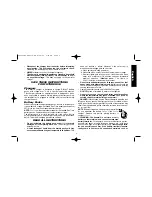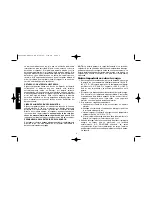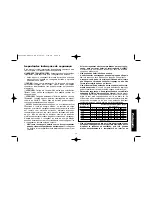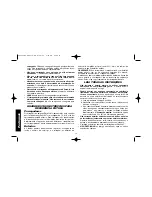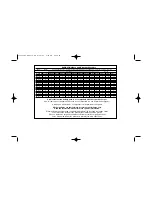
English
3
keys, coins, hand tools and the like.
The US Department of
Transportation Hazardous Material Regulations (HMR) actually
prohibit transporting batteries in commerce or on airplanes (i.e.,
packed in suitcases and carry-on luggage) UNLESS they are
properly protected from short circuits. So when transporting individ-
ual batteries, make sure that the battery terminals are protected
and well insulated from materials that could contact them and
cause a short circuit.
CAUTION:
Battery pack must be securely attached to tool. If
battery pack is detached, personal injury may result.
Charging Procedure
DANGER:
Electrocution hazard. 120V/127V or 220V volts
present at charging terminals. Do not probe with conductive
objects. Danger of electric shock or electrocution.
1. Plug the charger into an appropriate outlet before inserting
battery pack.
2. Insert the battery pack into the charger. The red (charging) light
will blink continuously indicating that the charging process has
started.
3. The completion of charge will be indicated by the red light
remaining ON continuously. The pack is fully charged and may
be used at this time or left in the charger.
Using Automatic Tune-Up™ Mode
The automatic Tune-Up™ Mode equalizes or balances the indi-
vidual cells in the battery pack allowing it to function at peak
capacity. Battery packs should be tuned up weekly or after 10
charge/discharge cycles or whenever the pack no longer delivers
the same amount of work. To use the Automatic Tune-Up™, place
the battery pack in the charger and leave it for at least 8 hours.
Indicator Light Operation
Charge Indicators
Some chargers are designed to detect certain problems that can
arise with battery packs. Problems are indicated by the red light
flashing at a fast rate. If this occurs, re-insert battery pack into the
charger. If the problem persists, try a different battery pack to
determine if the charger is OK. If the new pack charges correctly,
then the original pack is defective and should be returned to a
service center or other collection site for recycling. If the new bat-
tery pack elicits the same trouble indication as the original, have
the charger tested at an authorized service center.
HOT/COLD PACK DELAY
Some chargers have a Hot/Cold Pack Delay feature: when the
charger detects a battery that is hot, it automatically starts a Hot
Pack Delay, suspending charging until the battery has cooled.
After the battery has cooled, the charger automatically switches to
the Pack Charging mode. This feature ensures maximum battery
life. The red light flashes long, then short while in the Hot Pack
Delay mode.
PROBLEM POWER LINE
Some chargers have a Problem Power Line indicator. When the
charger is used with some portable power sources such as genera-
tors or sources that convert DC to AC, the charger may temporarily
646193-00,DW9116,BR 8/24/06 2:16 PM Page 3
Содержание DW9116
Страница 18: ...646193 00 DW9116 BR 8 24 06 2 16 PM Page 17 ...



